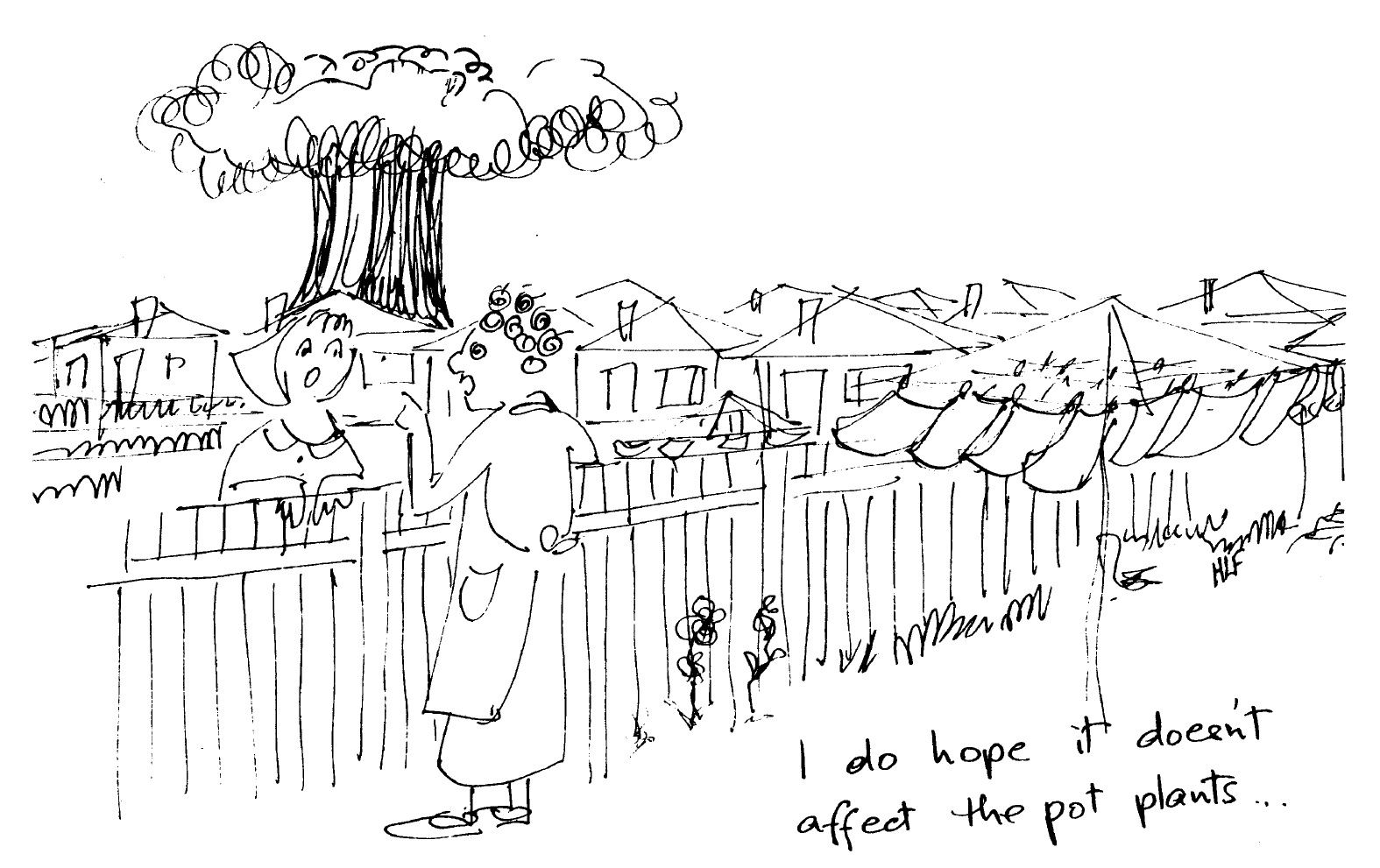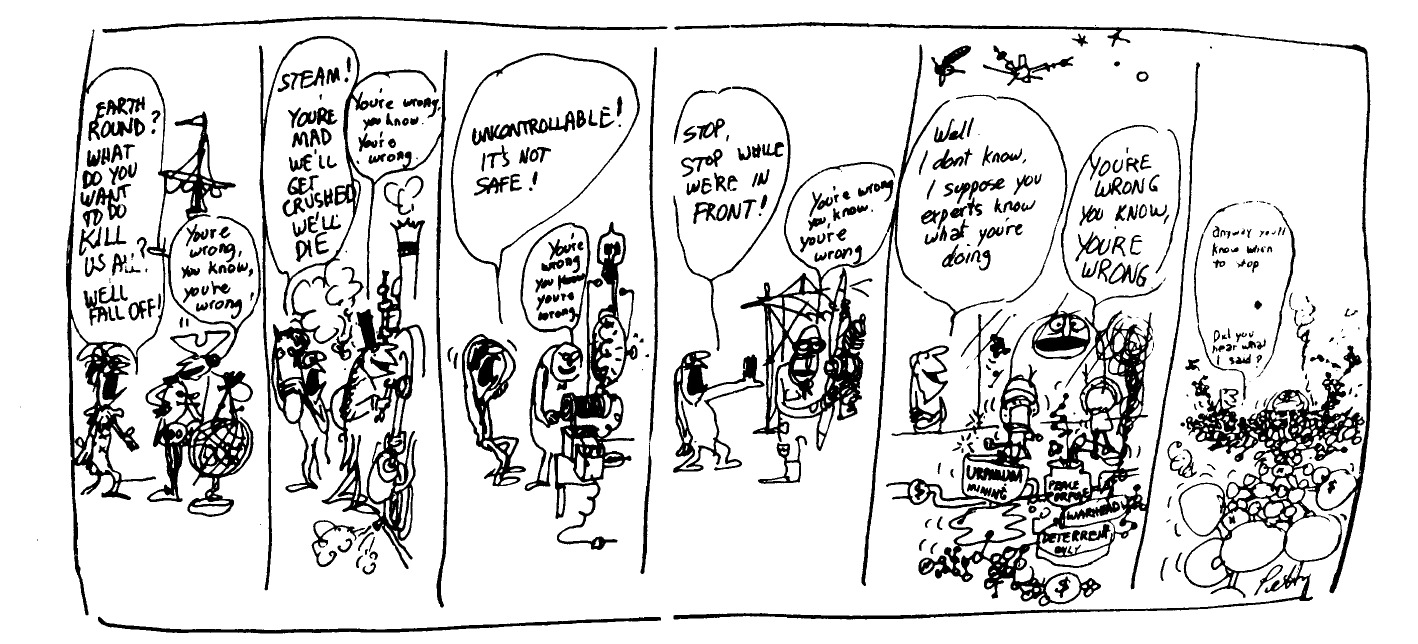
Before you read further, we invite you to write down your answers to the following ten questions. You can find the answers after the first cartoon.
1 How many nuclear bombs are there in the world today?
2 Which country has most nuclear bombs?
3 If a global nuclear war occurred next week (using nearly all the nuclear bombs that exist), what percentage of the world's population would be killed?
4 How likely is a global nuclear war to occur in the next 10 years?
5 If a nuclear bomb with explosive power of one megatonne (equivalent to one million tonnes of TNT, or 50 times the power of the Hiroshima bomb) were exploded 10 kilometres from you, what would be your chance of survival?
6 Which countries should Australia be militarily linked with?
7 What is the chance that Australian military forces will take over the Australian government within the next 20 years?
8 If Australian military forces took over the Australian government, and you opposed the takeover, what could you do about it?
9 What is there about Australian society that you consider so important that you would seriously risk your life to defend it?
10 What should be done to help bring about world peace?

1 How many nuclear bombs are there in the world today?
There are probably about 70,000 nuclear bombs in the world. The exact number is unknown, due to military secrecy.
2 Which country has most nuclear bombs?
The United States has most. One estimate is that the US has 33,000 nuclear bombs and the Soviet Union 16,000 in their operational forces; they keep many others in storage. Other countries definitely having nuclear weapons are Great Britain, France, and China. India has exploded a nuclear bomb and Israel is widely considered to have a number of them. Other countries either possibly have or are close to having nuclear bombs, in particular Pakistan and South Africa.
3 If a global nuclear war occurred next week (using nearly all the nuclear bombs that exist), what percentage of the world's population would be killed?
The number of people killed in nuclear war depends on many things, including the countries involved (for example, whether China is heavily bombed); the targets selected (for example, population centres or military targets); civil defence preparations (if any), such as evacuation; the prevalence of secondary effects, such as fire storms or the dispersal of the cores of nuclear power plants; the incidence of epidemics, whether spontaneous or from biological warfare agents; the rate of agricultural and economic recovery and the incidence of starvation or social breakdown.
Most of those killed would die from the immediate effects of nuclear blast and heat or from exposure to fallout during the first few days. A major nuclear war in which many population centres were attacked could kill 400 to 500 million people, mainly, in the United States, the Soviet Union, Europe, and perhaps China. This would be about 10 per cent of the world's population.
Aside from immediate effects, radioactivity from nuclear explosions in the long term could kill only a small percentage of the world's population from cancers and genetic defects, according to present knowledge, though this could amount to many millions of people over a period of decades or centuries.
The number of deaths from a global nuclear war is not as great as thought by some people. But Canberra Peacemakers believes that the likely death, suffering, and destruction from such a war is more than large enough to justify enormous effort to oppose nuclear war and the groups whose policies lay the basis for it.
4 How likely is a global nuclear war to occur in the next 10 years?
There is a range of opinion about this question. Many would say that the chance of a global nuclear war in the next decade is small but significant. Two developments are increasing the risk: (1) the introduction of highly accurate strategic missile systems by the United States and the Soviet Union, plus developments in anti-submarine warfare and communications and control systems, which increases the chance that one of the two superpowers may undertake a "first strike" in an attempt to destroy the opponent's nuclear forces; (2) the spread of the capability to make nuclear weapons to more and more countries, fostered by the expansion of the nuclear power industry.
5 If a nuclear bomb with explosive power of one megatonne (equivalent to one million tonnes of TNT, or over 50 times the power of the Hiroshima bomb) were exploded 10 kilometres from you, what would be your chance of survival?
The main dangers from a nuclear explosion are from blast, heat, initial radiation, and (if the bomb explodes near the ground) from fallout during the first few days. At 10 km distance the chance of death from blast effects or initial radiation is very small. Survival of the thermal radiation (heat) depends on physical shielding. An unprotected person in the direct line of sight of the explosion at 10 km in a clear atmosphere could receive lethal burns from the thermal radiation, while a person shielded by walls of a building or by a hill probably would be unaffected by the heat.
The danger from fallout during the first few days depends mainly on the direction and speed of the wind and on physical shielding. If the wind blows from the explosion away from a person, there is little or no danger from fallout. If the wind blows from the explosion directly or partially towards a person, a lethal dose of radiation will be received by an unprotected person. The dose can be reduced by shielding, for example by a factor of 3 by being in the centre of the ground floor of a brick veneer house, and by much larger factors by being in a basement.
Overall, the chance of survival of a one megatonne nuclear explosion at 10 km distance would be perhaps 80-90 percent. But many more of those closer to the blast would be killed. A one megatonne nuclear bomb exploded in a major Australian city could kill up to several hundred thousand people. Many of those who survived would be injured.

6 Which countries should Australia be militarily linked with?
This is a matter of opinion, based on one's assessment of the benefits and costs of military alliances. The stance of Canberra Peacemakers is that Australia should not have military links with any country, and should pursue a nonaligned and independent foreign policy, supporting international initiatives for justice, equality, and peace.
7 What is the chance that Australian military forces will take over the Australian government within the next 20 years?
Australia has a long history of civilian government control of the military, and the chances of a military takeover are probably quite small. However, there are a number of examples of military coups in countries with previous long histories of solid democratic rule, such as Uruguay. This may happen because of increasing social and political conflict, due for example to declining economic prosperity. Military takeovers also might occur as responses to crises and emergencies either in Australia or overseas, such as terrorism (whether real or artificially created) or nuclear war.
8 If Australian military forces took over the Australian government, and you opposed the takeover, what could you do about it?
For those who oppose a military takeover, there are three types of response: (1) do nothing; (2) oppose the takeover violently, for example through urban guerrilla warfare; and (3) oppose the takeover nonviolently.
Violent opposition is likely to be ineffective in an industrialized country like Australia, because military and police forces have an overwhelming superiority of resources for violence. Violent tactics also increase death and suffering, and repel many potential supporters.
Canberra Peacemakers supports the response of nonviolent opposition. This approach includes denial actions (strikes, boycotts, etc.); overt confrontations (sit-ins, non-cooperation with orders, etc.); symbolic actions demonstrations etc.; alternative structures (communications, food distribution, etc.).
In nonviolent resistance everyone can contribute in some way, large or small, for example by telling neighbours to resist, helping produce a leaflet or newspaper, joining or organising civil disobedience, or just reporting sick and not going to work. There are a number of historical examples that demonstrate the power of nonviolent resistance to military takeovers, such as the collapse of the Kapp Putsch (Germany, 1920) and the failure of the generals' revolt in Algeria (France, 1961).
9 What is there about Australian society that you consider so important that you would seriously risk your life to defend it?
To many people this question implies risking one's life in a military operation to defend Australian territory or interests. But it could also mean being willing to risk one's life by defending nonviolently against an invader or by protesting nonviolently against a government which denied certain rights or freedoms. Often in the past people have sacrificed their lives by acting nonviolently to support racial equality, women's rights, decent working conditions, freedom of religion, freedom of speech, and freedom of political opinion.
10 What should be done to help bring about world peace?
The stance of Canberra Peacemakers is that governments and world leaders cannot be relied upon to bring about world peace. Attempts to persuade governments to initiate disarmament have failed consistently. What are needed are initiatives from people in all walks of life which challenge the powerful system of governments, corporations, and bureaucracies which thrive on the threat of war.
Canberra Peacemakers looks to several key areas for action to change the war system: campaigns for justice and equality, campaigns to oppose political repression, and campaigns to end exploitation of poor people and poor countries; conversion of military production to production for human needs; substitution of military defence by social defence based around planned social, economic, and political non-cooperation; strengthened machinery for peacemaking (such as improved communications and methods for negotiation and consensus decision-making); transformation of repressive and hierarchical government, bureaucratic, and corporate structures to attain a more decentralized and locally self-managed society.
Canberra Peacemakers encourages action in these areas in all countries, capitalist and communist, with participation by as many people as possible in learning to use nonviolent methods to achieve social change and to attain a non-violent society.

These questions were developed by Canberra Peacemakers, an activist group working for peace and social change through grassroots nonviolent action. The questions were given to about 150 people in Canberra and their responses analysed. If you are interested in the results of the survey, a copy can be obtained from the Environment Centre. A summary of the most important findings follows.
These findings suggest that two areas need attention in the promotion of peace. These are the fostering of public discussion and debate, and the development of a strategy whereby people may participate in helping move towards some of the more general goals such as disarmament.
Stockholm International Peace Research Institute, Yearbook 1980.
Samuel Glasstone and Philip J. Dolan, The Effects of Nuclear Weapons (Washington, D.C.: United States Department of Defense, 1977).
Adam Roberts, "Civil resistance to military coups", Journal of Peace Research, volume 12, pages 19-36 (1975).
Anders Boserup and Andrew Mack, War Without Weapons: Non-violence in National Defence (London: Frances Pinter, 1974).
Robert Aldridge, The Counterforce Syndrome: a Guide to US Nuclear Weapons and Strategic Doctrine (Washington, D.C.: Transnational Institute, 1978).
Gene Sharp, The Politics of Nonviolent Action (Boston: Porter Sargent, 1973).
Robert Cooney and Helen Michalowski (editors), The Power of the People: Active Nonviolence in the United States (Culver City, California: The Power of the People Publishing Project, 1977).